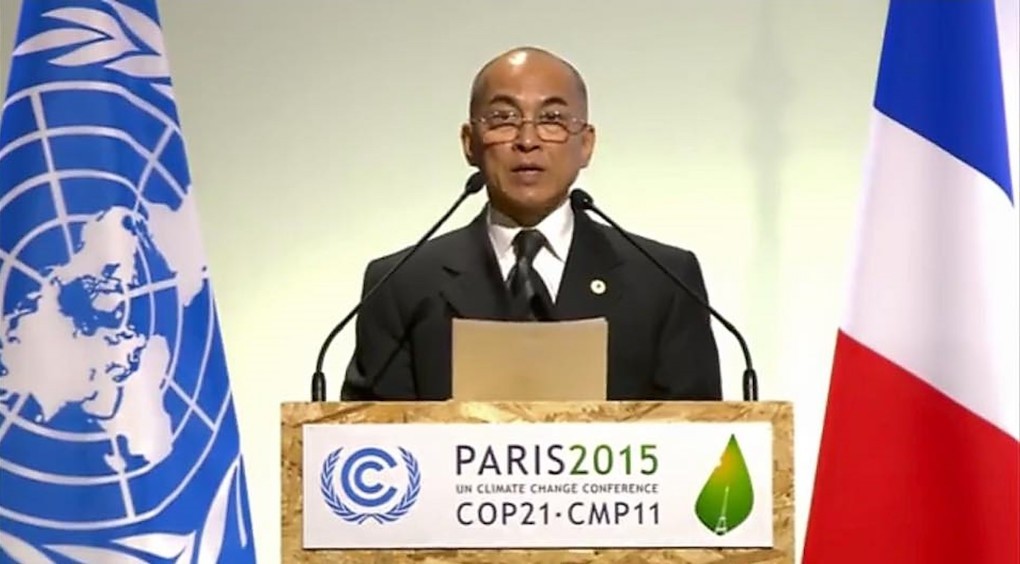In December 2015, world leaders reached a landmark climate change agreement during the COP 21 summit in Paris. Signatories committed to do their utmost to reduce carbon and greenhouse gas emissions in order to limit global temperature increases to within 2°C or, if possible, to 1.5°C of pre-industrial levels.
Citing employment losses, Donald Trump, president of the world largest carbon polluter in history, however, announced in May the United States’ withdrawal from the deal. This sent a shock wave around the world and was seen as a sign of a betrayal to small nations that are severely threatened by the unprecedented impacts of climate change. Absent the US, the rest of the world is not backing down, and in fact it appears to be more united and committed to realize the Paris accord.
Generally, least developed and small nations like Cambodia can do a lot to join the fight against climate change by reducing carbon emission through a shift toward green power. More importantly, Cambodia can also seize this opportunity to become a leader in renewables within Southeast Asia if it can organize to invest more in green technology, particularly wind, solar and biomass power sources.
Since 2015, Cambodia has committed to honoring COP 21 in order to mitigate impacts of climate change. Some solid contributions are being pursued through forest conservation in protected areas, yet energy efficiency and conservation still lack a clear policy or program.
Cambodia Focuses on Power Generation Mix
In past years, Cambodia, due to its limited technology and limited access to financial capital, remained heavily reliant on fossil fuel and hydro power energy, both of which represent major threats to the environment.
According to the 2016 renewable energy report by WWF, over 6 million Cambodians lack access to electricity. The government has set an ambitious goal to achieve 100 percent nationwide electrification by 2020. Moreover, domestic electricity consumption increases 20 percent annually due to rapid economic growth and development. This represents a a tremendous increase in supplies needed. Unfortunately, the government has chosen not to focus on clean, renewable energy to meet this demand, preferring a mix dominated by large hydropower development instead.
“Cambodia has a policy to promote renewable energy in its power generation mix, but this is really biased toward the 2 GW of hydropower capacity it wants installed by 2020,” says Dr. Han Phoumin, Energy Economist at Economic Research Institute for ASEAN and East Asia (ERIA). “Cambodia lacks a feed-in tariff policy to subsidize the premium price required to support more green power generation”, he adds.
Public-Private Partnership Needed in Renewable Energy Sector
Cambodia has been identified as having great potential for both wind and solar power in the region.
“Cambodia has 5.8 peak sunlight hours a day, one of the best solar resources in the region: probably one of the best in the world. You mix that with high electricity rates, and this is a very good market,” says Ken Bradley, Director of Business Development at Kamworks in B2B Cambodia.
Energy experts suggest that Cambodia should apply more effort to formulate a specific renewable energy policy, adding that it should particularly target solar and wind and mobilize private sector support to invest more in clean energy generally.
Dr. Han Phoumin says, “To promote solar and wind energy, there must be the right policy in place, especially a feed-in tariff.”
“However, solar energy is becoming competitive due to lower costs. We see some solar farms emerging within and for special economic zones in Cambodia without the policy support. This is because the electricity cost in Cambodia from the grid remains expensive,” he notes.
In addition to establishing feed-in tariff, the government also has to boost support for public-private partnership which will bring more investment into the renewable energy sector. When asked what step the government should take to achieve this, Dr. Han responds that some regulations to limit the use of oil and gas by setting renewable energy targets should too be formulated.
“The government will need to regulate the downstream oil and gas activities; this also includes the requirement for industries to comply with policies in which the government plays a role to set renewable use targets”, he argues, “This is similar to what’s often required in transportation to support biofuels. A specified mix is required, so the industries have to seek a way to respond to the policy. Therefore, renewable energy will have its market.”
Cambodia Makes a Significant Move in Solar Energy to reduce large amount of greenhouse gas
With regards to solar energy, Cambodia has made some significant progresses recently. In April, the Asian Development Bank (ADB) gave the green light to finance Cambodia’s first large-scale solar farm in Bavet, a special economic zone located in the Southeastern province of Svay Rieng.
ADB’s $9.2 million loan will allow Cambodia’s public enterprise Electricité Du Cambodge (EDC) to complete the 10 MW installation, scheduled for operation in August. This capacity represents a reduction of 5,500 tons of carbon dioxide equivalent (CO2) annually relative to a fossil-fuel burning plant—a momentous move by Cambodia in promoting clean energy in order to reduce the impact of climate change.
This article is from Thmey Thmey Media and represents the views of the author only.





